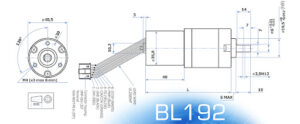Micro Motors manufactures a series of brushless gearmotors with a wide possibility of reduction ratios. Brushless motors differ from conventional DC motors by the absence of brushes, a technology that guarantees higher and longer-lasting performance, necessary in certain types of automation. In this article, we will discover how a brushless gearmotor works, its advantages, and how to choose the right one based on the reduction ratio.
What is a brushless gearmotor and how it works
A brushless gearmotor is a motor with a built-in gear mechanism (such as multi-stage or planetary gears). The gears are connected to the motor drive shaft. The gears engage with one another to step down the speed of the brushless DC motor while also increasing the output torque.
Brushless DC motors are typically operated at the maximum speed of 5,000 rpm where they achieve excellent efficiency. If the motor is combined with a gearbox that has a 20:1 gear ratio, for example, this speed can be stepped down to 250 rpm with a considerable increase in torque (approx. 20 times).
 Advantages of brushless gearmotors
Advantages of brushless gearmotors
The use of brushless motors offers several advantages:
- Brushless motors have a longer lifetime since without brushes they are not subject to the wear caused by the brush-collector contact, which is a limitation of the conventional brush motors.
- For low-speed/high-torque applications, in particular, they offer a wide range of options.
- Brushless motors can be combined with various types of gearboxes developed to provide quiet operation and excellent drivetrain efficiency.
In Micro Motors’ product range, brushless motors are coupled with high-precision planetary gearboxes which increase motor torque and reduce speed, making them suitable for many fields of application.
The advantage of choosing brushless motors is a longer lifetime compared to brush motors, low noise, and low interference. Micro Motors uses a brushless motor with integrated electronics.
Micro Motors offers a series of brushless gearmotors
Contact us if you have an inquiry
Differences between DC gearmotors and brushless gearmotors
In a traditional direct-current, electric motor brushes transfer electricity to the copper winding of the motor by contact.
The friction resulting from the sliding of the brushes on the collector, connected to the winding, is responsible for:
- increased noise;
- the formation of sparks;
- wear of the brushes themselves.
As a result, electric motors are susceptible to more frequent maintenance or replacement of contacts and brushes.
Brushless motors instead develop a magnetic interaction between the permanent rotor magnets and the stator electromagnets, triggering a continuous and constant rotation that transmits electricity without any direct contact.
How to choose the correct brushless gearmotor
 As can be seen in the above table, there are different brushless gearmotor reduction ratios that result in a wide range of torques, speeds, and sizes. As mentioned in our article about how to choose the correct reduction ratio, selecting the correct reduction ratio is essential to ensure that the gearmotor you choose is the most suitable for the application. On Micro Motors’ website, you can consult the interactive tab and select the characteristics required to identify the appropriate reduction ratio.
As can be seen in the above table, there are different brushless gearmotor reduction ratios that result in a wide range of torques, speeds, and sizes. As mentioned in our article about how to choose the correct reduction ratio, selecting the correct reduction ratio is essential to ensure that the gearmotor you choose is the most suitable for the application. On Micro Motors’ website, you can consult the interactive tab and select the characteristics required to identify the appropriate reduction ratio.
Micro Motors series BL 192
Micro Motors manufactures series BL 192, brushless motors with different reduction ratios. Below you will find the technical data:
- Brushless gearmotor with electronics on-board
- Brushless motor 3 phase 12 pole with 3 Hall sensors
- The outgoing shaft is supported by two ball bearings
- Maximum radial shaft load: 200N (10 mm from the fixing flange)
- Maximum axial shaft load: 100N
- Temperature working range: -10 °C/+50 °C
- Approx weight: 320/420g
Micro Motors offers a series of brushless gearmotors

 Advantages of brushless gearmotors
Advantages of brushless gearmotors

